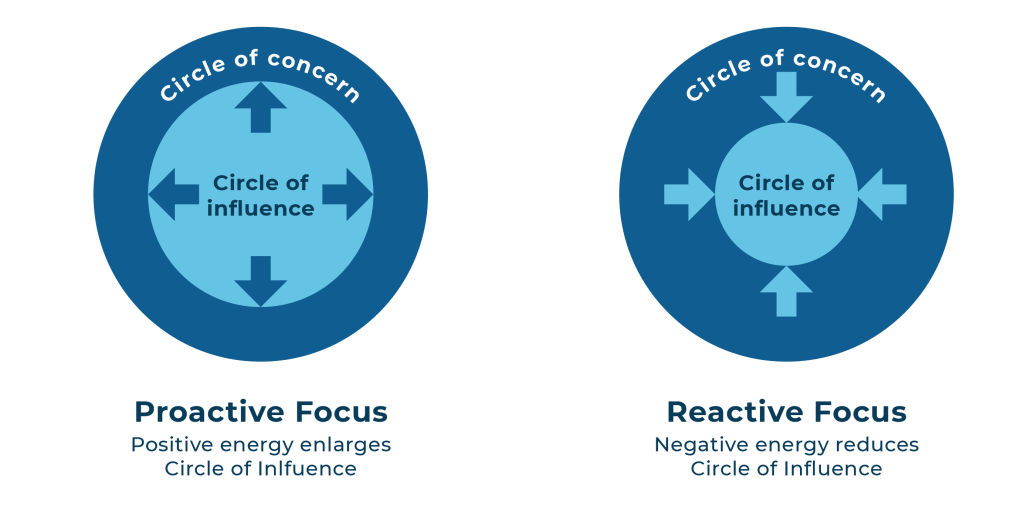3.5 Proactivity Versus Reactivity
Proactivity and reactivity are two fundamentally different approaches to decision-making and everyday behaviour.
Proactivity involves making intentional and deliberate decisions with a focus on both present and future outcomes. It empowers individuals to anticipate challenges, plan ahead, and act purposefully, leading to consistent progress towards optimal being over the long term.
Reactivity involves responding to situations as they occur, often without preparing or considering future outcomes. This approach is often present in those who consistently seek immediate self-gratification, or only respond when a serious problem arises that could have been avoided. This often results in inconsistent outcomes that may negatively affect physical, emotional, and mental health.
Key Features of Proactivity
- Future-oriented thinking: Guided by an understanding of long-term goals and values, ensuring that actions today contribute positively to future outcomes.
- Ownership and responsibility: Full responsibility is taken for choices and outcomes. Addresses potential challenges by seeking solutions in advance.
- Intentional action: Decisions are made with careful thought and purpose, focusing on what can be controlled rather than reacting to external influences primarily out of one’s control.
Examples of Proactive Choices
- Scheduling regular exercise to prevent health issues later.
- Choosing nutritious meals today to enhance long-term vitality.
- Journaling or seeking therapy to address emotions before they escalate.
- Joining a club or group to foster meaningful relationships.
- Setting aside time to connect with family or friends regularly.
- Learning a new skill or hobby to stimulate cognitive growth.
- Setting career goals and pursuing professional development opportunities.
- Meditating or reflecting daily to find clarity and purpose.
- Saving a portion of income for future needs or emergencies.
- Taking initiative to start tasks that need to or should be done.
Key Features of Reactivity
- Short-Term Focus: Prioritize immediate relief or convenience, often neglecting future consequences.
- Lack of Control: Feelings of powerlessness or being overwhelmed leading to emotional or impulsive responses to challenges.
- Dependence on External Factors: Actions are influenced by outside forces, leaving little room for intentional or strategic decision-making.
Examples of Reactive Choices
- Skipping meals and eating unhealthy snacks when hunger strikes.
- Avoiding exercise until a health scare arises.
- Bottling up emotions until they lead to an outburst or breakdown.
- Relying on social interactions only when feeling lonely or isolated.
- Procrastinating on learning or self-improvement until a deadline or crisis looms.
- Taking on too much work without addressing burnout until productivity drops.
- Reacting to financial crises by borrowing or overspending without a plan.
- Waiting to seek medical attention only when symptoms become severe.
- Avoiding career planning until faced with job dissatisfaction or layoffs.
- Waiting for other people to initiate tasks that need to or should be done.
Side by Side Comparison
| Aspect | Proactivity | Reactivity |
|---|---|---|
| Definition | Making intentional decisions and taking deliberate actions with future outcomes in mind. | Responding to events or situations as they happen, often without planning. |
| Focus | Long-term solutions and goal-oriented actions. | Short-term fixes and immediate responses. |
| Approach to Challenges | Anticipates challenges and plans ahead to mitigate them. | Reacts to challenges as they arise, often without preparation. |
| Sense of Control | Feels in control of their circumstances and actions. | Feels controlled by external circumstances. |
| Decision-Making | Thoughtful, purpose-driven, and aligned with goals. | Impulsive, often influenced by emotions or external pressures. |
Covey’s Circles
Proactivity involves prioritizing energy on areas of one’s life that truly matter and where tangible impact can be had. But this raises important questions: What do you actually have control over? How much control do you truly have?
Stephen Covey, the author of The 7 Habits of Highly Effective People, proposed a simple yet powerful model consisting of three circles to help conceptualize this idea: the Circle of Concern, the Circle of Influence, and the Circle of Control (Covey, 1989).

Circle of Concern
Includes everything you might care about or worry about in life that you have little to no control over. It encompasses broad topics such as global events, other people’s opinions, or future uncertainties.
While these issues may matter to you, they are often outside your ability to directly affect you. Spending too much time focusing on the Circle of Concern can lead to feelings of helplessness or frustration, as it includes things beyond your control.
Examples:
-
Global climate change
-
The economy or job market
-
Natural disasters
-
Government policies
-
Other people’s choices or opinions
-
World conflicts
-
A coworker’s bad attitude
Circle of Influence
Represents the areas where you can have an impact, even if you cannot fully control the outcomes. For example, you may not be able to change someone’s behaviour, but you can influence them through your actions, words, or examples. By focusing your energy here, you can make a positive difference while avoiding the frustration of worrying about things you can’t change.
Examples:
-
The morale in your workplace
-
Your child’s homework habits
-
A friend’s decision-making (through conversation/support)
-
Your overall physical health and well-being
-
Your personal financial situation
-
Your professional network or reputation
Circle of Control
The innermost circle is where your personal power lies. It includes everything you have direct control over, such as how you respond to your thoughts and feelings.
Focusing your efforts on this circle enables you to take responsibility for your life and act in ways that align with your goals and values, thus cultivating a proactive mindset that fosters growth and resilience.
This leads us to the understanding that proactivity and reactivity directly affect these circles. As the figure below shows, positive energy enlarges the circle of influence, and negative energy reduces it.


